

Feeding My Family Makes Me A Terrorist? According to Senator Rand Paul (and rampant internet rumor), "someone who has more than seven days of food in their house can be considered a potential terrorist.
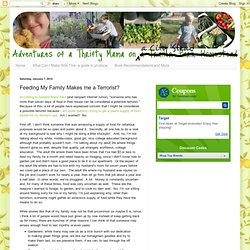
" Because of this, a lot of people have expressed concern that I might be considered a possible terrorist because I am (quite publicly) trying to get a year's supply of food stored for my family's use. Am I worried? No.
Bulk Food Cheap: LDS Storehouses. One of my readers had sent me an email last week wanting to know where to find the storehouses run by the Church of Jesus Christ of Latter Day Saints (or the Mormon church as we’re sometimes called) in order to buy bulk food for long-term food storage.

I thought I’d answer this question in a blog post so that all can benefit from it. I’ll also provide some insight into what they are, what you can find there, and of course where you can find them. What is an LDS Storehouse? For those not familiar with the storehouses, I thought I’d explain what they are and what their purpose is. The LDS storehouses (or Bishop’s Storehouse as we call them) were established as part of the welfare system set up by the Church which aims at providing assistance to needy families and individuals within (as well as outside) the Church.
Funding for the welfare program (which includes the storehouses) is provided by donations from Church members. iPhone App Find Free Fruit: NeighborhoodFruit.com. Introducing Find Fruit, your mobile companion of NeighborhoodFruit.com!
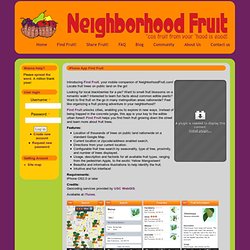
Locate fruit trees on public land on the go! Looking for local blackberries for a pie?
Substitutes For Baking Ingredients. Let’s say the power has been out for several days, social unrest and violence is at an all time high, and you and your family have decided to “bug in” until the worst is over.
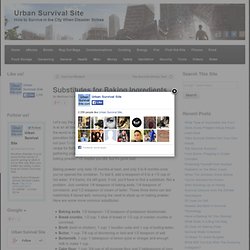
You all need a morale boost, so you decide to make pancakes for breakfast. You get your camp grill going, put a griddle on it, get out your Emergency Food Storage & Survival Handbook and look up the recipe for fluffy buttermilk pancakes. You go through your food cache, start gathering your ingredients, and then you realize, “I never stocked up on baking powder!” Or maybe you did, but it’s gone bad. Baking powder only lasts 18 months at best, and only 3 to 6 months once you’ve opened the container. Dehydrating Eggs Picture Tutorial Recipe & Video.
Homesteading: Food. How To: Gut, Skin & Field Dress. Foraging. What Will We Eat? Full Key for Plant Identification: Go Botany. Common Non-Edible Plants. 5 Invasive Plants You Can Eat. The logic of eating wild plants is obvious; the logic of eating invasive wild plants is even more so.

Culling aggressive species that have a negative impact on native plants, while avoiding the environmental pitfalls of agriculture? And free, local and abundant? Yes, please. Invasive plants are non-native species that can thrive in areas beyond their natural range of dispersal. These plants are characteristically adaptable, aggressive, and have a high reproductive capacity. According to the Land Management Bureau, millions of acres of once-healthy, productive rangelands, forestlands and riparian areas have been overrun by noxious or invasive plants. So what can we do? 1. Native range: Old World, probably Southeast Asian in origin Invasive range: Throughout North America Habitat: Rocky bluffs, barnyards, gardens, sidewalk cracks, disturbed areas; widely found in city lots. 2. The pretty leaves are alternate, egg shaped; stems are hollow. 3. 4. 5. Famine Food Homepage. By Bob Freedman 50 E.
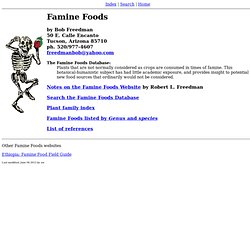
Calle Encanto Tucson, Arizona 85710 ph. 520/977-4607 freedmanbob@yahoo.com The Famine Foods Database: Plants that are not normally considered as crops are consumed in times of famine. This botanical-humanistic subject has had little academic exposure, and provides insight to potential new food sources that ordinarily would not be considered. Notes on the Famine Foods Website by Robert L.
Top 10 Invasive Species You Can Eat. DIY: Beer Can Into Camping Stove. You can whip one of these up in a matter of minutes.

They’re so easy to make and they work really well. First find yourself some scissors and a beverage can and then start the above video. This is an inexpensive way to be prepared in the event of a power outage as these stoves give off a lot of heat and have the ability to cook large meals. They also make great holiday gifts for friends and family. For more great repurposing ideas, check out Repurposing 24/7 Image: Vimeo camp stoveDIYRepurposing Related Posts.
Bushcraft Oven Experiment. Clean Your Cooking Gear with Wood Ashes. Using wood ashes as a cleaning agent makes alot of sense: they are readily available, free, and relatively safe for the environment when compared to many types of soap.
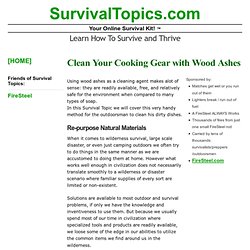
In this Survival Topic we will cover this very handy method for the outdoorsman to clean his dirty dishes. Re-purpose Natural Materials When it comes to wilderness survival, large scale disaster, or even just camping outdoors we often try to do things in the same manner as we are accustomed to doing them at home. However what works well enough in civilization does not necessarily translate smoothly to a wilderness or disaster scenario where familiar supplies of every sort are limited or non-existent. Solutions are available to most outdoor and survival problems, if only we have the knowledge and inventiveness to use them. Often it is simply a matter of key pieces of information missing in our expertise, which once provided suddenly gives us a powerful new way to accomplish necessary tasks.
Easy Access to Soap is Limited. Bushcraft Pit Oven How To. How To Open A Can Without A Can Opener.